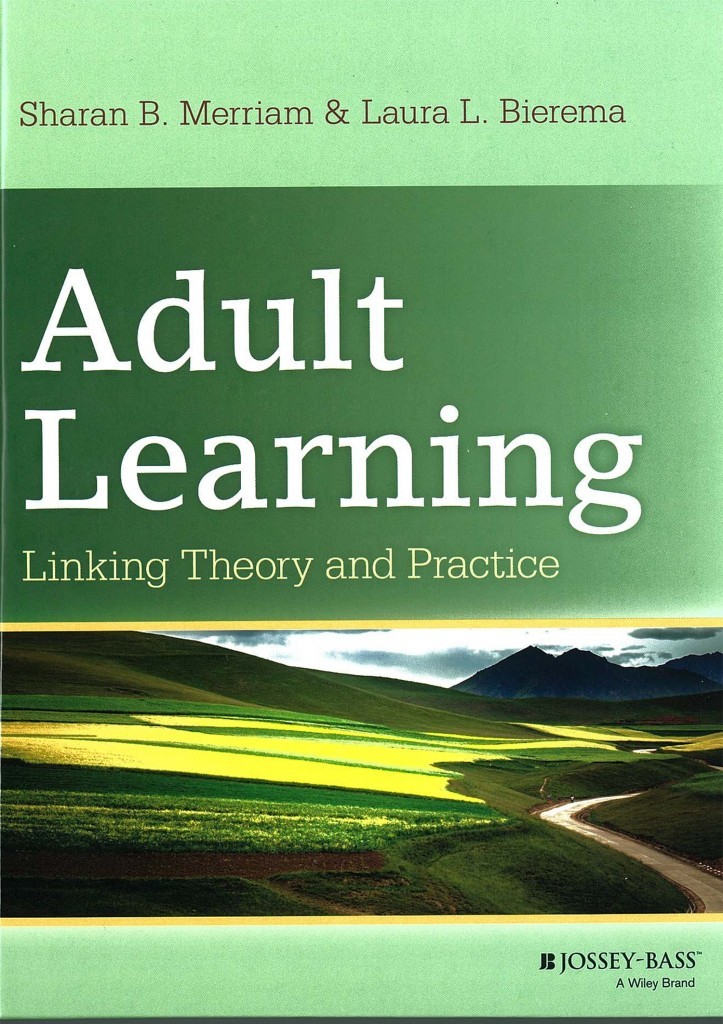Adult Learning: Linking Theory and Practice by Sharan B. Merriam & Laura L. Bierema
Jossey-Bass, San Francisco, 2014
302 pages
Sharan Merriam and Laura Bierema, authors of Adult Learning: Linking Theory and Practice, were chosen as the UPCEA 2015 recipients of the Philip E. Frandson Award for Literature. This award recognizes newly published works that contribute to the theory and/or practice of professional and continuing higher education. The committee unanimously agreed that this text, written by very experienced adult educators, reconceptualizes existing scholarship on adult learning and moves the field forward through effectively linking theoretical constructs to practice and applications for a variety of audiences. This book is a well-written resource manual for new and experienced university, professional, and continuing education practitioners working with adult learners. The book is divided into twelve informative and meaningful chapters providing connections to the latest research and practice found in the field of adult learning.
Book Summary
Chapter One, Adult Learning in Today’s World, focuses on definitions of adult learners and forces that impact their ability to learn in a world with changing demographics, increasing technology, and globalization. In Chapter Two, Traditional Learning Theories, the authors provide a definition of learning and examine common and emerging theories of learning related to adults. Chapter Three, Andragogy: The Art and Science of Helping Adults Learn, covers the basic tenets of the seminal adult learning theory/model and provides a connection to the history of the field of adult learning. Chapter Four, Self-Directed Learning, describes self-directed learning, the types of self-directed learning, provides an overview of how self-directed learning is carried out, myths of self-directed learning, and ways to implement in varying contexts. Chapter Five, Transformative Learning, defines transformative learning, provides practical applications for carrying out transformative learning in various contexts, and examines the latest critiques of the concept. Chapter Six, Experience and Learning, explores how experience impacts learning and examines models that connect experience with learning, among them reflective practice and situated cognition. Chapter Seven, Body and Spirit, takes the readers in a different direction from traditional books on adult learning, incorporating some of the latest writing on the connection between learning and non-cognitive realms, body and spirit. Chapter Eight, Motivation and Learning, focuses on motivation theory, defining motivation, and conditions that enable learners to feel motivated. Chapter Nine, The Brain and Cognitive Functioning, provides a primer on memory, definitions and types of intelligence, development of intelligence, and construct of wisdom. Chapter Ten, Adult Learning in the Digital Age, examines the prevalence of technology in our lives and the rise of e-learning for adults, both in formal and informal settings, and ways that changing technology impacts educators as they work with adult learners. Chapter Eleven, Critical Thinking and Critical Perspectives, delves into the definition of critical theory and its connection to critical thinking and provides a strong approach to encouraging critical thinking within adult learners. Chapter Twelve, Culture and Context, Theory and Practice in Adult Learning, closes out the book with an exploration of the role context plays in learning and education and proposes a framework for adult learning focused on lifelong learning and reflective practitioners.
Chapter Organization
Each chapter is organized with clearly defined sections focusing on the major theories and their critiques. The sections of each chapter include narratives and personal experiences connected to the topics, description of the topic and related theories, inquiries for the reader to explore how the topic has impacted them, practical applications of the theories, and questions and activities readers can use to incorporate the topic in their classroom or everyday lives. The chapters conclude with a Chapter Summary; Linking Theory and Practice: Activities and Resources; and Chapter Highlights.
Connection to Professional and Continuing Education Providers
Readers will find the authors’ style of writing easy to follow, insightful, and approachable. What makes this book unique is the authors’ decision to include chapters normally not found in adult learning textbooks. Topics such as transformative learning, body and spirit, critical thinking, and culture and context are usually addressed peripherally in other books on adult learning. Here, the authors give these subjects prominence, which will be widely appreciated by practitioners who deal with a variety of adult learners within their respective centers. University professional and continuing education practitioners will find the clear and accessible explanations of the theories combined with insightful practical applications helpful as they work to provide quality continuing and online programs based in best practices and the latest research. Adult Learning: Linking Theory and Practice will provide new practitioners in the field a strong foundation in adult learning theory and practice while educating seasoned practitioners about emerging concepts and research to help them improve their respective centers.
Jim Berger, Ph.D. has been a professor in the field of adult education for over fourteen years, has served in leadership roles at local, state, and national levels, and has published over 29 articles, chapters, and reports. He has served as editor of the inaugural Journal of Research and Practice in Adult Literacy, Secondary, and Basic Education. He currently coordinates the MAE in Adult Education and two certificate programs at Western Kentucky University.
Beth Laves, Ed.D. is a long-standing member of UPCEA and a 2015 member of the Frandson Committee. She is Associate Vice President, Division of Extended Learning and Outreach, at Western Kentucky University.

